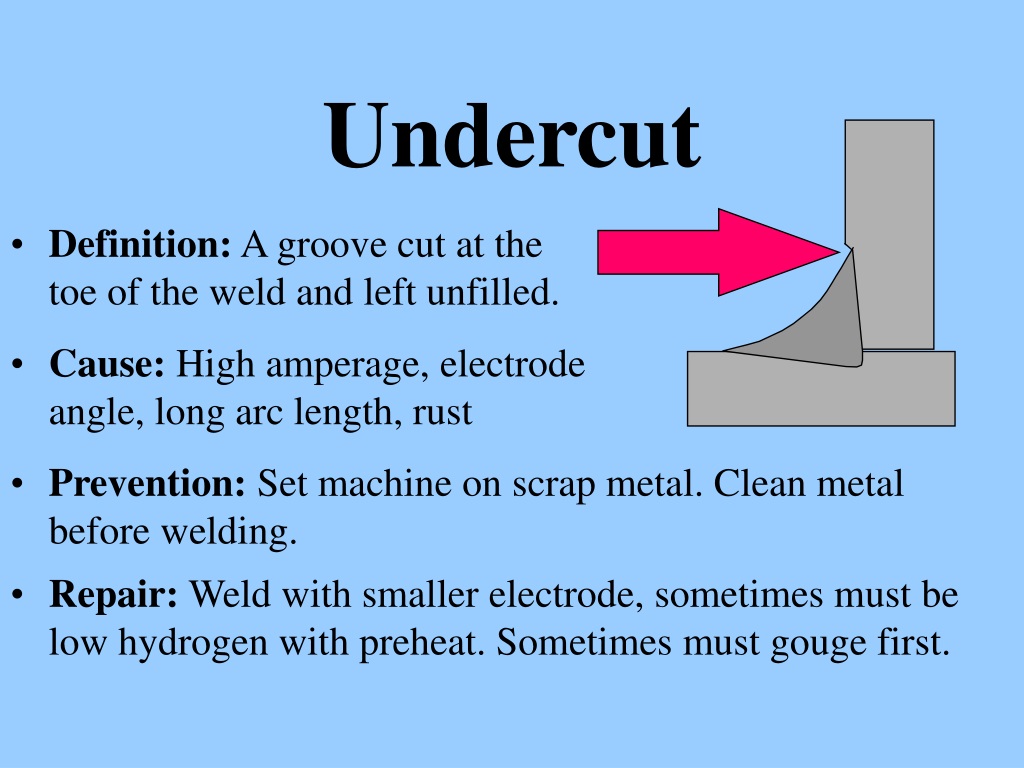Reliable Ways to Prevent Weld Undercut in Your Welding Projects
Reliable Ways to Prevent Weld Undercut in Your Welding Projects
Blog Article
A Comprehensive Guide to Identifying, Preventing, and Dealing With Undercut Welding Troubles in Your Welding Projects
In the world of welding, coming across undercut issues is an usual challenge that can endanger the structural integrity and general quality of your welding jobs. Comprehending the origin behind undercut welding, being able to accurately identify it in your welds, and carrying out reliable preventative procedures are important abilities for any type of welder. Furthermore, having the expertise and techniques to correct undercut troubles when they do take place can make a significant difference in the last result of your welding endeavors. Remain tuned as we discover the necessary components of recognizing, stopping, and dealing with undercut welding troubles, providing you with beneficial understandings and strategies to elevate your welding abilities to the next level.
Common Causes of Undercut Welding
Undercut welding, a typical issue in welding processes, can be caused by various variables that need to be very carefully determined and resolved to make sure the integrity of the weld joint. One of the key reasons of undercut welding is extreme warm input.
An additional common root cause of undercut welding is incorrect welding strategy. Inadequate adjustment of the welding torch or gun, inaccurate angle or distance in between the lantern and the workpiece, or irregular travel speed can all add to the development of undercut. In addition, utilizing the wrong welding consumables or electrode size for a particular joint arrangement can bring about undercut issues. Recognizing these source and implementing corrective steps is essential in stopping and fixing undercut welding troubles in welding projects.
Identifying Undercut in Welds

To identify undercut properly, appropriate lights and magnifying tools are important to evaluate the weld joint extensively. Using devices such as a welding gauge or a magnifying glass can assist in discovering even the smallest undercut imperfections. In addition, running a finger or a finger nail along the weld joint can occasionally disclose undercut, as the surface area might really feel uneven or have a dip where the undercut exists.
Safety Nets for Undercut
Having a deep understanding of the reasons of undercut in welds permits for the execution of effective precautionary actions to maintain weld quality and integrity. One critical preventive measure appertains weld joint prep work. Making sure that the edges are clean, without contaminants, and properly beveled can substantially lower the probability of undercut (Preventing weld undercut). Furthermore, selecting the appropriate welding specifications, such as voltage, existing, and travel rate, is crucial. These settings must be enhanced to avoid excessive warm input, which can lead to damage formation.

Strategies for Repairing Undercut

To deal with undercut problems efficiently, welders can use particular methods targeted at remedying the issue and restoring the honesty of the weld joint. One strategy is to adjust the welding specifications, such as the voltage, existing, and travel speed, to ensure appropriate heat input and combination. Increasing the welding present or minimizing the traveling speed can assist fill up in the undercut. In addition, changing the welding strategy from a push to a drag or the other way around can also aid minimize undercut.
Another method is to utilize a weaving activity while welding to guarantee appropriate sidewall combination and fill in the undercut. By oscillating the welding arc back and forth within the weld joint, the welder can transfer much more filler material into the undercut areas, efficiently removing the problem.
In addition, grinding out the undercut and rewelding the joint can be a practical option for extra extreme undercut concerns - Preventing weld undercut. This process involves removing the undercut section, preparing the base steel, and afterwards rewelding the joint with appropriate welding specifications and strategies to avoid undercut from reoccurring

Specialist Tips for Avoiding Undercut
Using proper welding strategies and maintaining control over key welding criteria are important approaches for welders intending to prevent undercut in their weld joints. Furthermore, picking the ideal welding procedure and filler metal for the certain application can aid prevent undercut. Maintaining a constant travel rate throughout the welding procedure is another important tip to prevent undercut.
Conclusion
Finally, determining, avoiding, and repairing undercut welding problems in your welding tasks is crucial for ensuring strong and internet sturdy welds. Preventing weld undercut. By recognizing the usual sources of undercut, being able to identify it in welds, carrying out preventative steps, and using proper techniques for repairing undercut, you can stay clear of prospective concerns and produce high-grade welds. Following professional pointers for staying clear of undercut can assist you boost your welding skills and generate far better outcomes in your tasks
Undercut welding, a typical concern in welding processes, can be created by numerous variables that require to be carefully determined and resolved to ensure the honesty of the weld joint. Furthermore, running a finger or a fingernail along the weld joint can often reveal undercut, as the surface YOURURL.com area might really feel irregular or have a dip where the undercut exists.
Utilizing proper welding techniques and keeping control over essential welding parameters are critical methods for welders intending to protect against undercut in their weld joints.In final thought, identifying, preventing, and dealing with undercut welding troubles in your welding tasks is critical for making certain strong and sturdy welds. By recognizing the typical causes of undercut, being able to determine it in welds, implementing preventive actions, and utilizing proper strategies for taking care of undercut, you can stay clear of possible concerns and produce premium welds.
Report this page